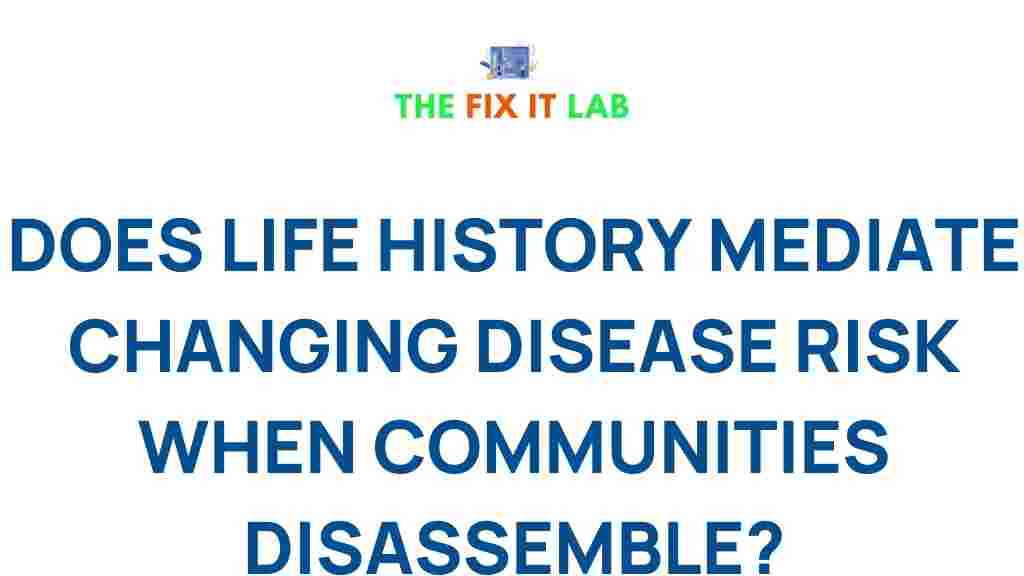Understanding the Role of Life History in Disease Risk
Life history, a field in evolutionary biology, focuses on how organisms allocate resources to growth, reproduction, and survival throughout their lifespan. This allocation plays a critical role in shaping health outcomes and disease risks. By delving into the evolutionary traits and behavioral patterns tied to life history, we can uncover the mechanisms behind susceptibility to illnesses and chronic conditions.
What Is Life History?
Life history refers to the patterns and strategies organisms develop to maximize their survival and reproduction. These strategies include:
- Age of first reproduction
- Number and size of offspring
- Parental investment in offspring
- Life expectancy
These traits are influenced by evolutionary pressures, environmental conditions, and genetic factors. Understanding these elements provides valuable insights into the biology of diseases and the trade-offs our bodies face over time.
How Life History Shapes Disease Risk
Our life history strategy is deeply intertwined with disease risk. Let’s explore how this connection unfolds:
- Reproductive Timing: Early reproduction might prioritize short-term survival at the expense of long-term health, increasing susceptibility to diseases in later life.
- Energy Allocation: Energy devoted to growth and reproduction can divert resources from immune function, leaving the body vulnerable to infections.
- Parental Investment: High parental effort may lead to reduced physical resilience in parents, influencing their disease risk as they age.
The Evolutionary Trade-offs in Life History
Life history strategies often involve trade-offs between growth, reproduction, and longevity. For example:
- Fast life history: Species or individuals with shorter lifespans reproduce quickly but may face higher risks of chronic diseases later in life.
- Slow life history: Longer-lived species or individuals invest more in maintenance and repair, potentially reducing early-life reproduction but enhancing long-term health.
These trade-offs highlight the evolutionary balancing act that influences health outcomes.
Steps to Analyze the Life History-Disease Risk Connection
Step 1: Gathering Life History Data
Start by identifying key life history traits, such as reproductive age, offspring number, and longevity. These traits vary across individuals and populations, providing the basis for understanding health risks.
Step 2: Identifying Environmental Influences
Environmental factors like nutrition, stress, and exposure to pathogens can shape life history strategies. For instance, harsh environments may accelerate reproductive timing but increase vulnerability to diseases.
Step 3: Linking Biology with Health Outcomes
Analyze how biological mechanisms, such as hormonal regulation and immune function, mediate the relationship between life history traits and disease risk. Research suggests that:
- Chronic stress during childhood, a critical period in life history, can predispose individuals to metabolic disorders.
- Early reproduction may be linked to cardiovascular diseases due to the body’s prioritization of reproductive over maintenance processes.
Step 4: Evaluating Long-Term Impacts
Consider the long-term implications of life history strategies. For example, societies with higher life expectancy may observe a shift in disease patterns, such as an increase in age-related illnesses like Alzheimer’s disease.
Troubleshooting Challenges in Life History Research
Studying the connection between life history and disease risk involves several challenges:
- Complex Data Collection: Gathering comprehensive life history data across populations requires significant resources and time.
- Individual Variability: Genetic, cultural, and lifestyle differences add complexity to interpreting results.
- Interdisciplinary Integration: Combining insights from biology, anthropology, and medicine can be daunting but is crucial for a holistic understanding.
Despite these hurdles, advancements in technology and cross-disciplinary collaboration are paving the way for deeper insights into life history and its impact on disease risk.
Examples of Life History in Action
To illustrate, consider these real-world applications:
- Life History in Epidemiology: Researchers study how childhood nutrition affects adult-onset diseases like diabetes and hypertension.
- Behavioral Insights: Cultural practices linked to family size and reproductive timing reveal patterns in disease susceptibility.
For more insights on related topics, explore our detailed guide on evolutionary medicine.
Concluding Thoughts on Life History and Disease Risk
The study of life history provides a unique lens to understand the intricate balance between evolution, behavior, and health. By examining how our biological past influences disease risks, we gain valuable tools to predict, prevent, and manage health outcomes across populations.
To delve deeper into this fascinating topic, check out this external resource on evolutionary biology.
In sum, life history not only shapes our biological journey but also offers profound insights into the mechanisms underlying health and disease. Embracing this knowledge is crucial for advancing both individual well-being and public health strategies.
This article is in the category News and created by TheFixitLab Team
